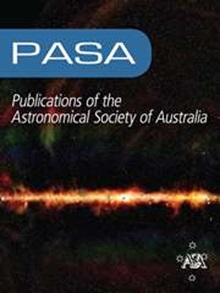EMU/GAMA:在低质量系统中探测活动银河核的技术
IF 4.6
3区 物理与天体物理
Q1 ASTRONOMY & ASTROPHYSICS
引用次数: 0
摘要
我们提出了一种在低质量(M* ≤ 1010M⊙)星系中识别活动星系核(AGN)的新方法。这种方法依靠光谱能量分布(SED)拟合来识别射电通量密度超过单纯恒星形成预期的星系。结合星系和质量总成(GAMA)G23 区域的数据(来自 GAMA、宇宙演化图(EMU)早期科学观测和宽视场红外巡天探测器(WISE)),我们将这种技术与一系列不同的 AGN 诊断方法进行了比较,以探索 AGN 分类的异同。我们发现,基于光学和近红外标准的诊断方法(标准 BPT 图、WISE 颜色标准和质量-激发图或 MEx 图)往往倾向于在高质、高亮度系统中探测 AGN,而 "ProSpect "SED 拟合工具则能在低质系统中有效地识别 AGN。我们研究了这一结果的解释,其背景是:低质量星系中的黑洞质量比高质量星系中的黑洞质量要低,AGN 和恒星形成的辐射在光学和红外波长上占主导地位的比例不同,这是星系恒星质量的函数。我们的结论是,由 SED 导出的 AGN 分类是识别具有低射电光度 AGN 的低质量宿主的有效方法。本文章由计算机程序翻译,如有差异,请以英文原文为准。
EMU/GAMA: A Technique for Detecting Active Galactic Nuclei in Low Mass Systems
We propose a new method for identifying active galactic nuclei (AGN) in low mass (M* ≤ 1010 M⊙ ) galaxies. This method relies on spectral energy distribution (SED) fitting to identify galaxies whose radio flux density has an excess over that expected from star formation alone. Combining data in the Galaxy and Mass Assembly (GAMA) G23 region from GAMA, Evolutionary Map of the Universe (EMU) early science observations, andWide-field Infrared Survey Explorer (WISE), we compare this technique with a selection of different AGN diagnostics to explore the similarities and differences in AGN classification. We find that diagnostics based on optical and near-infrared criteria (the standard BPT diagram, the WISE colour criterion, and the mass-excitation, or MEx diagram) tend to favour detection of AGN in high mass, high luminosity systems, while the “Pro Spect ” SED fitting tool can identify AGN efficiently in low mass systems. We investigate an explanation for this result in the context of proportionally lower mass black holes in lower mass galaxies compared to higher mass galaxies and differing proportions of emission from AGN and star formation dominating the light at optical and infrared wavelengths as a function of galaxy stellar mass. We conclude that SED-derived AGN classification is an efficient approach to identify low mass hosts with low radio luminosity AGN.
求助全文
通过发布文献求助,成功后即可免费获取论文全文。
去求助
来源期刊
CiteScore
5.90
自引率
9.50%
发文量
41
审稿时长
>12 weeks
期刊介绍:
Publications of the Astronomical Society of Australia (PASA) publishes new and significant research in astronomy and astrophysics. PASA covers a wide range of topics within astronomy, including multi-wavelength observations, theoretical modelling, computational astronomy and visualisation. PASA also maintains its heritage of publishing results on southern hemisphere astronomy and on astronomy with Australian facilities.
PASA publishes research papers, review papers and special series on topical issues, making use of expert international reviewers and an experienced Editorial Board. As an electronic-only journal, PASA publishes paper by paper, ensuring a rapid publication rate. There are no page charges. PASA''s Editorial Board approve a certain number of papers per year to be published Open Access without a publication fee.

 求助内容:
求助内容: 应助结果提醒方式:
应助结果提醒方式:


